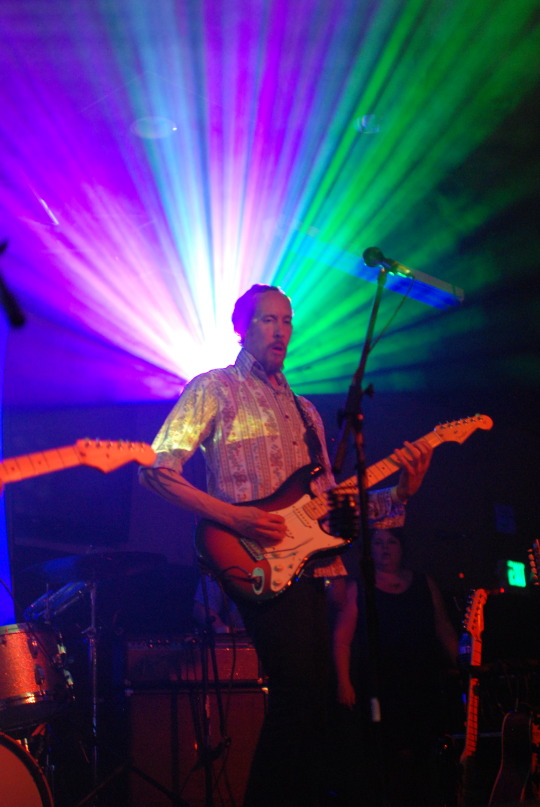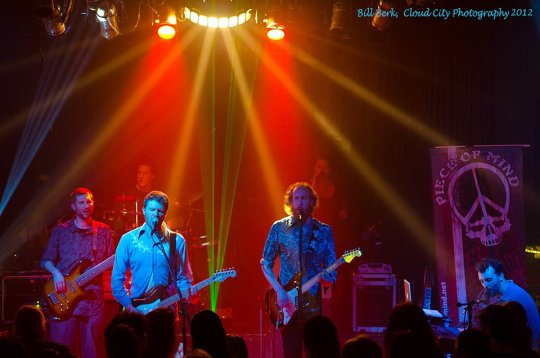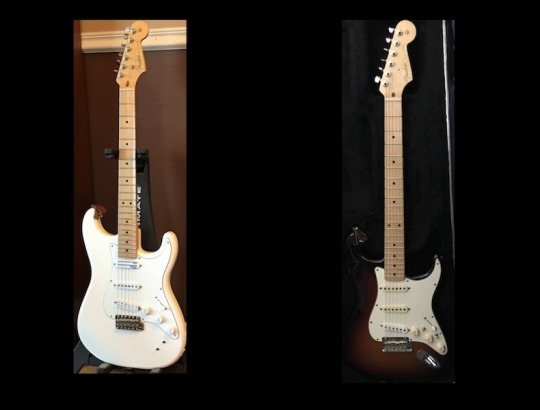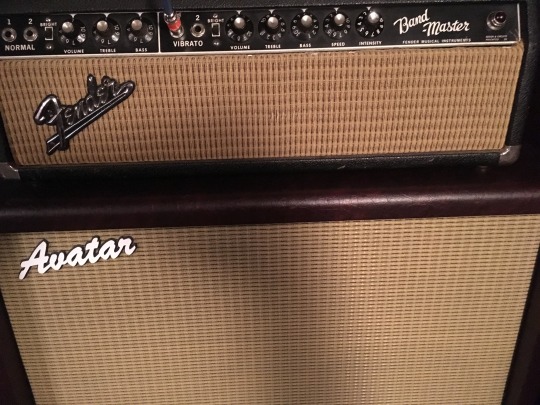#the strat trem arm just gets in the way a lot
Text
i wonder if i can stick a jazzmaster tremolo on my strat
0 notes
Text
We could become slaves to our equipment...volume 2
WARNING: GUITAR GEEK LANGUAGE FOLLOWS
David Lindenbaum is the second half of the Pigs on the Wing guitar team and an accomplished solo artist in his own right ( check out his solo album Ether Day if you have done so yet). While Dave is an old hand at performing Pink Floyd’s music, he actually came into the band a bit later - as Pigs on the Wing began life as a single-guitar band in the spirit of the original Pink Floyd. A seasoned and infinitely adaptable musician, Dave played his first gig with Pigs on the Wing as sub bassist - before convincing the band ( rightly so) that they really needed a 2nd guitarist. Today we’re going to take a look at Dave’s guitar setup for Pigs on the Wing - and the equipment he uses to achieve the classic Pink Floyd guitar tones.

Dave onstage with Pigs on the Wing in 2015
POTW: What is your approach in general terms to getting the David Gilmour sound ? Do you ever improvise or do you tend to play the parts note for note?
DAVE: As for as his sound, I shoot for something in the right ballpark. I’ve never tried to replicate his exact gear or anything, but have rather tried to stick to the spirit of it. For the parts I go mostly note-for-note, leaving windows here and there to be spontaneous. Here again, when I improvise I tend to stick with my perception of the spirit of the music. Once in a while I just cut loose and play off the top of my head, usually during sections where we’ve added jams that aren’t in the original arrangements.
For iconic stuff like the Brick Pt. 2 or Time solos, I play those note-for-note, figuring that fans expect to hear them that way, and also that I can’t improve on perfection. On lesser known stuff I’m more open to interpreting or improvising.

Pigs on the Wing in 2012
POTW: You came into this project after it was established, originally as a 1 guitar band - what was the process like for finding a place for both guitarists ?
DAVE: For me it was mostly a process of playing as little as possible at first and waiting to be invited to add more. I’ve always been a collaborative player, and think of my self as primarily a colorist, so that process happened naturally for me. Over time we had conversations about me taking on some of those iconic note-for-note parts since I knew many of them already. Jason likes to be a little looser and keep things a little more spontaneous, so we evolved organically into roles that suit our strengths as players. We sometimes have guitar practices where we go through each song and fine-tune our parts and how they work together. Generally we try to err on the side of leaving more space and playing less.
I’ve also become the de facto utility player, handling acoustic, lap steel, and other miscellaneous parts. Again this plays to our respective strengths because Jason mostly likes to play electric, whereas I grew up playing 12-string, nylon-string, and things like that. I learned to play songs like Fearless, Is There Anybody Out There?, and Wish You Were Here as part of learning guitar when I was a teenager, so it was natural for me take on that role in the band, to fill that need, if you like.

POTW guitars - onstage - 2018 Finding the Dark Side of the Moon tour
POTW: Let's talk about your guitars. Tell us about your main instrument(s) and why they work for this project.
DAVE: I’m pretty much a maple-neck Strat guy generally, probably because my first decent guitar as a kid was a Japanese Squier Bullet, a 3/4-size Strat body with a maple Tele neck. I played that guitar for 11 years before finally getting a Strat, so by then nothing else felt right in my hands but a Fender with a maple neck! Plus I think they’re more versatile than most other guitars. With the right pickups you can play any style of music with a Strat. I also like that Strats are a bit harder to play than other electrics. They make you work a little harder, so when I dig in things don’t get chaotic, unless I want them to. Over the years I’ve had four different Gibsons - a Les Paul, SG, Firebird, and ES330TD, in that order - and ended up selling all of them eventually.

Dave’s Stratocasters
I just got a new Strat that is quickly becoming my main electric - an Ed O’Brien (from Radiohead) signature Strat. It comes stock with pretty much all of the stuff I would want to mod a Strat with, like a Sustainer pickup and a mini-humbucker in the bridge, a Little JB. I had locking tuners put in and had it set up for 10s. I also ended up swapping necks with my now-former main Strat because the stock 21-fret V neck felt weird after 33 years playing C necks, most of which had 22 frets.
I love my Ebow, so the idea of the Sustainer was very appealing to me. I use it on Echoes and plan to use it extensively on Shine On when we bring that back into the set later this year. My now-backup guitar is a heavily modified 2011 sunburst American Standard Strat. I put a Duncan STK6 in the bridge, wired in a coil-tap switch, and put in a switch to add the neck pickup to the bridge out-of-phase. It also has a bone nut and locking tuners. As noted above, it now has the 21-fret V neck from the Ed O’Brien.
I use a Guild 12-string for all steel-string acoustic parts, except for Dogs, for which I play an old Yamaha 6-string tuned to D standard. I play a Yamaha nylon-string acoustic-electric for three songs on The Wall. I also play a Supro 6-string lap steel guitar in drop-D tuning for slide parts.

Dave’s pedalboard setup as of Sept 2018
POTW: How do you generate the distortion and overdrive effects ? Do you use a Big Muff ? How about the Leslie effects? What is the most irreplaceable pedal on your pedalboard ?
DAVE: I mostly use a Fulltone GT500 for distortion. I really prefer amp gain, but somehow ended up going this route a few years ago.
I recently incorporated a backwards-plugged wah to my setup for the creepy whale sounds on Echoes and Is There Anybody Out There? It works great unless you happen to use wireless, so I ended up adding an A/B switch so I can use a cable with the wah and wireless for everything else. I recently got a 5 channel looper pedal with an A/B so the current A/B will go away. It’s like Medusa’s head of snakes - every time I get rid of something, 2 more things take its place!
I have a Boss RT20 rotary speaker pedal that I like a lot. It’s versatile and indestructible. I also have three Analogman-modded pedals that I love - a Small Stone phase shifter, a VPJr volume pedal and a Boss TR2 tremolo. The most indispensable pedal on my board is definitely the Boss DD20 delay. Many Floyd songs are dependent on delay for tempo, so a good-sounding, reliable and programmable delay is crucial, and the Boss is all of those things; and like the RT20, really all Boss stuff, it’s indestructible. Our stuff takes a fair amount of abuse so roadworthiness counts for a lot.
POTW: Gilmour was known for playing through 100 watt Hiwatts at very high volume - what's your amp setup these days, and how is it similar or different from Gilmour's?
DAVE: I’m using a 1967 Fender BandMaster Head with two identical Avatar 2x12 8-ohm cabs. They are of the now-discontinued Vintage Diagonal series, which means the speaker board is mounted on a slight upwards tilt to facilitate being easier to hear on stage. They each have one Vintage 30 and one G12H30 speaker. I have to give a big shout-out to Avatar for making me a second cab to my specs despite discontinuing both the model in particular and custom orders in general.
My setup is different from Gilmour’s in that it is significantly lower wattage - 50 compared to a couple hundred or more, depending on how many heads he uses nowadays - and I play at a comparatively low volume. Similar to Gilmour, my rig is set up for clean headroom as opposed to high gain.

Dave’s amp rig - Sept 2018
POTW: On that note - how is your rig similar or different from Jason's rig ? Is it ever chaos having 2 guitars on stage at the same time ? How do you guys create space for both instruments ?
DAVE: My rig is very different from Jason’s in a couple of ways. He uses an Orange head into a Marshall 4x12, and uses the effects loop for his pedals. His amp has a high gain channel that he uses for most of his leads. My rig doesn’t have an effects loop so my pedalboard runs straight into the amp. Jason uses cables, whereas I am wireless.
On the other hand, we both have pretty similar pedal layouts, including 2 or 3 of the same pedals, and we both use tube amps. I started using Gilmour-style short trem arms after seeing how much Jason liked his, and Jason turned me on to Analogman pedal mods.
It can be a little chaotic with the two of us, especially on really loud and jammy songs like Interstellar Overdrive or the middle part of Echoes. As mentioned earlier, we put a lot of time into arrangements so we don’t step all over each other. It helps that neither of us are showboats or egotists. We’re pretty mellow and considerate. And sometimes a little chaos is a good thing! Mostly we try to avoid having our combined stage volumes blow out the eardrums of our band mates, our audiences, or ourselves, and/or irritate Shira, our FOH sound engineer.

Pigs on the Wing live 2018
POTW: Last question: Boss or EHX pedals ?
DAVE: Yes, please. I am an equal-opportunity pedal nerd.
#pigs on the wing#pink floyd#analogman#fender#stratocaster#david gilmour#guitargeek#pink floyd tribute
3 notes
·
View notes